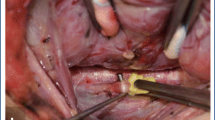Abstract
The effect of different concentrations of rocuronium bromide used for anesthesia induction during thyroid surgery on the intraoperative recurrent laryngeal nerve monitoring was evaluated. One hundred patients undergoing thyroid operation were randomized into five groups (20 patients per group). Patients in group I were operated and monitored without the use of rocuronium bromide. Patients in groups II–V were respectively injected with 0.5x, 1x, 1.5x, and 2x ED95 rocuronium bromide intravenously. The time from injecting the rocuronium bromide to the beginning of tube insertion was recorded, the conditions of tracheal intubation were evaluated, and the changes in blood pressure and pulse during the intubation process were monitored. Vagus nerve/recurrent laryngeal nerve evoked muscle potential was monitored using the NIM-Response3.0 nerve electromyography monitor. The amplitude of electromyography signal was recorded every 5 min during 30 min after successful tracheal intubation. The tracheal intubation success rate was 100 % in all groups. Compared with group I, intubating condition scores (Cooper scores) in the patients of groups II–V were higher (P < 0.05). The stability of intraoperative neuromonitoring signal amplitude in groups I–III met the monitoring standards. The findings suggest that the use of 0.5x or 1x ED95 rocuronium bromide during the anesthesia induction can improve the tracheal tube conditions without affecting the intraoperative recurrent laryngeal nerve monitoring. The use of 1x ED95 rocuronium bromide induction was associated with the best results.
Similar content being viewed by others
References
Minahan, R. E. (2002). Intraoperative neuromonitoring. Neurologist, 8(4), 209–226.
Chu, K. S., Tsai, C. J., Lu, I. C., et al. (2010). Influence of nondepolarizing muscle relaxants on intraoperative neuromonitoring during thyroid surgery. J Otolaryngol Head Neck Surg, 39(4), 397–402.
Sloan, T. B. (2013). Muscle relaxant use during intraoperative neurophysiologic monitoring. Journal of Clinical Monitoring and Computing, 27(1), 35–46.
Peng, C., Feng, L., Zhengbo, S., et al. (2012). Effect of 1x ED95 rocuronium on IONM mentoring for patients with thyroid surgery. Chinese Journal of Anesthesiology, 05, 525–527.
Christou, N., & Mathonnet, M. (2013). Complications after total thyroidectomy. J Visc Surg, 150(4), 249–256.
Dionigi, G., Bacuzzi, A., Boni, L., et al. (2010). The technique of intraoperative neuromonitoring in thyroid surgery. Surg Technol Int, 19, 25–37.
Lee, C., & Stack, B. C, Jr. (2011). Intraoperative neuromonitoring during thyroidectomy. Expert Review of Anticancer Therapy, 11(9), 1417–1427.
Barczyński, M., Randolph, G. W., Cernea, C. R., et al. (2013). External branch of the superior laryngeal nerve monitoring during thyroid and parathyroid surgery: International Neural Monitoring Study Group standards guideline statement. Laryngoscope, 123(Suppl 4), S1–S14.
Domosławski, P., Lukieńczuk, T., Kaliszewski, K., et al. (2013). Safety and current achievements in thyroid surgery with neuromonitoring. Adv Clin Exp Med, 22(1), 125–130.
Hayward, N. J., Grodski, S., Yeung, M., et al. (2013). Recurrent laryngeal nerve injury in thyroid surgery: a review. ANZ J Surg, 83(1–2), 15–21.
Hui, S., Xiaoli, L., Yantao, F., et al. (2010). Application of IONM in complicated thyroid surgery. Chinese Journal of Practical Surgery, 30(1), 66–68.
Xiuli, M., Jun, W., & Liping, Z. (2006). The effect of atracurium on facial nerve monitoring in ear surgery. Chinese Journal of Minimally Invasive Surgery, 02, 137–141.
Higgins, T. S., Gupta, R., Ketcham, A. S., et al. (2011). Recurrent laryngeal nerve monitoring versus identification alone on post-thyroidectomy true vocal fold palsy: a meta-analysis. Laryngoscope, 121(5), 1009–1017.
Cernea, C. R., Brandão, L. G., & Brandão, J. (2012). Neuromonitoring in thyroid surgery. Curr Opin Otolaryngol Head Neck Surg, 20(2), 125–129.
Sanabria, A., Silver, C. E., Suárez, C., et al. (2013). Neuromonitoring of the laryngeal nerves in thyroid surgery: a critical appraisal of the literature. European Archives of Oto-Rhino-Laryngology, 270(9), 2383–2395.
Pisanu, A., Porceddu, G., Podda, M., et al. (2014). Systematic review with meta-analysis of studies comparing intraoperative neuromonitoring of recurrent laryngeal nerves versus visualization alone during thyroidectomy. Journal of Surgical Research, 188(1), 152–161.
Chu, K. S., Wu, S. H., Lu, I. C., et al. (2009). Feasibility of intraoperative neuromonitoring during thyroid surgery after administration of nondepolarizing neuromuscular blocking agents. World Journal of Surgery, 33(7), 1408–1413.
Lu, I. C., Tsai, C. J., Wu, C. W., et al. (2011). A comparative study between 1 and 2 effective doses of rocuronium for intraoperative neuromonitoring during thyroid surgery. Surgery, 149(4), 543–548.
Marusch, F., Hussock, J., Haring, G., et al. (2005). Influence of muscle relaxation on neuromonitoring of the recurrent laryngeal nerve during thyroid surgery. British Journal of Anaesthesia, 94(5), 596–600.
Hemmerling, T. M., Schmidt, J., Hanusa, C., et al. (2000). Simultaneous determination of neuromuscular block at the larynx, diaphragm, adductor pollicis, orbicularis oculi and corrugator supercilii muscles. British Journal of Anaesthesia, 85(6), 856–860.
Hemmerling, T. M., & Donati, F. (2003). Neuromuscular blockade at the larynx, the diaphragm and the corrugator supercilii muscle: a review. Canadian Journal of Anaesthesia, 50(8), 779–794.
Plaud, B., Debenb, B., Lequeau, F., et al. (1999). Mivacurium neuromuscular block at the adductor muscles of the larynx and adductor pollicis in humans. Anesthesiology, 85(1), 77–81.
Sharpe, M. D., Moote, C. A., Lam, A. M., et al. (1991). Comparison of integrated evoked EMG between the hypothenar and facial muscle groups following atracurium and vecuronium administration. Canadian Journal of Anaesthesia, 38(3), 318–323.
Acknowledgments
This work was supported by projects of society development plan from Changchun Science and Technology Division (12SF53) and the key support projects of science and technology from Jilin Provincial Science and Technology Department (20130206038SF).
Author information
Authors and Affiliations
Corresponding author
Rights and permissions
About this article
Cite this article
Han, Yd., Liang, F. & Chen, P. Dosage Effect of Rocuronium on Intraoperative Neuromonitoring in Patients Undergoing Thyroid Surgery. Cell Biochem Biophys 71, 143–146 (2015). https://doi.org/10.1007/s12013-014-0176-1
Published:
Issue Date:
DOI: https://doi.org/10.1007/s12013-014-0176-1




